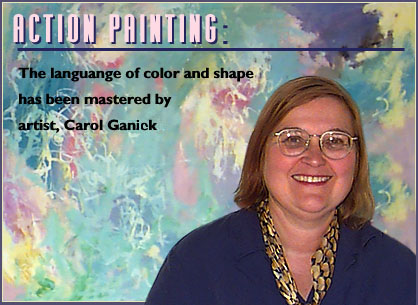 by Gary Vey
When we usually think of art, we tend to imagine some representation of nature, or of a person or objects. We enjoy looking at painted landscapes or a vase of colorful flowers - reflections of the pleasant memories and experiences in our real world. But what Avon, Connecticut's Carol Ganick does is something that goes a step further.
"I guess you'd call me an action painter," mused Carol in her cramped Farmington Valley Arts Center studio. "I usually start with a feeling, which suggests certain colors..." Carol applies the colors to the canvas or watercolor paper in what appear to be random strokes, creating odd blobs of color and broad strokes of streaked paint.
Some colors, red for example, are known to instinctively get the mind's attention (because of its similarity to blood). It's human nature. But the relationships that occur when two unique colors share the proximity and transparency that is evident in Carol's creations are more complex due to her skilled use of subtle gradiations in tone and color. For example, she showed me some of her "dark pieces" which, although mostly black and dark blue, had brighter statements that were uplifting and bright.
So what makes Carol's style of art more interesting than, say, a painting of a vase of flowers or of a beautiful landscape, is that her work can be both - and much more. Carol's work represents a moment - an emotional moment - that has been captured in time in the universal language of color and shape.
In his famous work, "The Spirit of Man in Art and Literature," Carl Jung notes the following of true artists:
"The creative process, so far as we are able to follow it at all, consists in the unconscious activation of an archetypal image, and in elaborating and shaping this image into a finished work. By giving it shape, the artist translates it into the language of the present, and so makes it possible for us to find our way back to the deepest springs of life. Therein lies the social significance of art: it is constantly at work educating the spirit of the age, conjuring up the forms in which the age is most lacking."
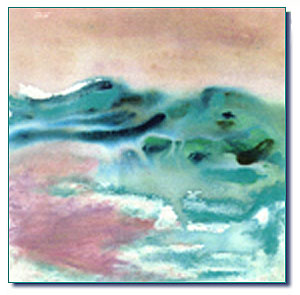 To some viewers, Carol Ganick's work is simply beautiful and something that brightens up their lives. Her larger works especially can instantly engage attention, yet blend like camouflage in a large room. To others, Carol's work has very personal and subjective meaning. Some see vegetation while others see doorways and images as if from some dream that can barely be recalled. How do you know when a piece of work is finished? Carol's response was that she reaches a stage in her painting when, she "stands back and reacts to it, and cannot see the need to continue." If all this sounds kind of abstract, or maybe a bit too personal a description of Carol Ganick's "action painting," then you will have to be your own judge. These paintings are both pleasing to the eye and stimulating to the mind and can be seen either at Carol's Avon studio (at Studio No. 9 in the Farmington Arts Complex - just off Rt. 44 in Avon), or at one of her many local shows which will be listed below. Carol also teaches at the West Hartford Art League and is the recipient of numerous awards and recognitions. If you enjoyed this story, please also see a different style of painting courtesy of Viewzone's archives. |
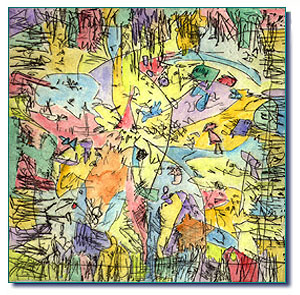 When it comes to applying a name to Carol's style, sadly, terms like "expressionism" and "abstract" fall short of the process of producing these beautiful and colorful works.
When it comes to applying a name to Carol's style, sadly, terms like "expressionism" and "abstract" fall short of the process of producing these beautiful and colorful works. 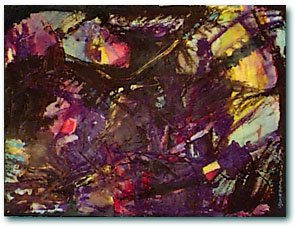 I was reminded of an experience in Montreal, in the early 1980's, where a group of painters regularly met in a punk style dance hall that had been transformed into a collective painting party on Friday evenings. As the DJ played Euro-style techno tunes, the assembled artists would commence expressing the moment on their individual canvases. The results were unpredictable and always unexpected. Unfortunately, this movement ended when the hall caught fire from the combination of flamable spray paint and someone's cigarette. But the ultimate freedom of expression is still alive and thriving in Carol's studio.
I was reminded of an experience in Montreal, in the early 1980's, where a group of painters regularly met in a punk style dance hall that had been transformed into a collective painting party on Friday evenings. As the DJ played Euro-style techno tunes, the assembled artists would commence expressing the moment on their individual canvases. The results were unpredictable and always unexpected. Unfortunately, this movement ended when the hall caught fire from the combination of flamable spray paint and someone's cigarette. But the ultimate freedom of expression is still alive and thriving in Carol's studio.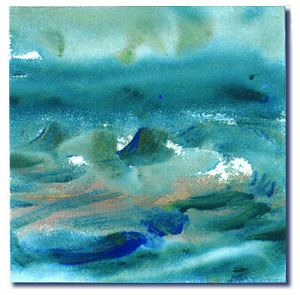 Carol herself will admit that she is often witness to her own creative talent, as it seems to just come through her. He application of paint, although influenced by her extensive education in formal art and design, is prompted more by her feelings and interactions with her work on an emotional level. She uses color and shape as a kind of language that conveys to the viewer a myriad of emotional and subjective responses.
Carol herself will admit that she is often witness to her own creative talent, as it seems to just come through her. He application of paint, although influenced by her extensive education in formal art and design, is prompted more by her feelings and interactions with her work on an emotional level. She uses color and shape as a kind of language that conveys to the viewer a myriad of emotional and subjective responses.